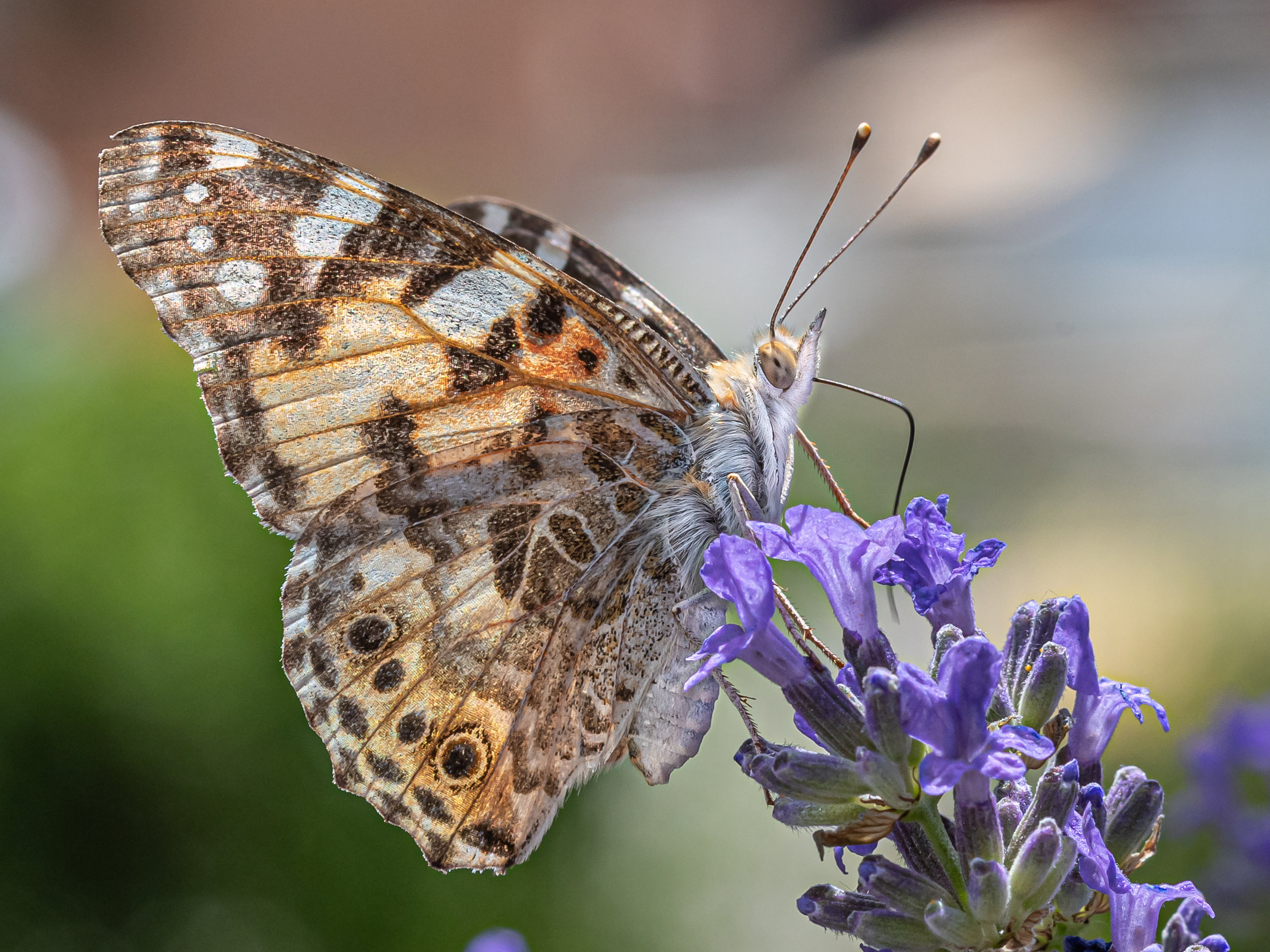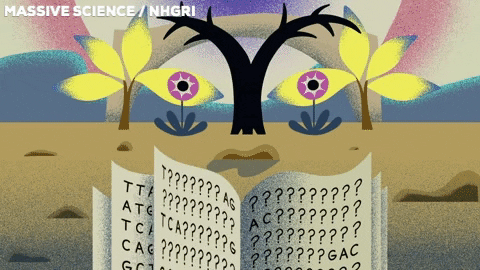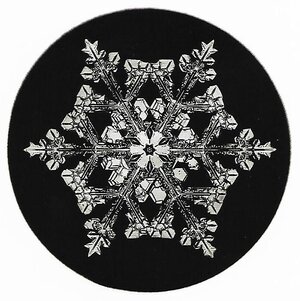Lab Notes
Short stories and links shared by the scientists in our community
Algae keep nitrogen savings to help them survive nutrient-poor ocean waters
Guanine, one of the four bases of DNA, also keeps algae's nitrogen sources rich
Via Wikimedia
For microalgae, the microscopic organisms photosynthesizing in the ocean, nitrogen is crucial in regulating metabolism. When nitrogen levels dip, their cells don't divide efficiently and they can't photosynthesize as well as when nitrogen is not limited. So how do microalgae continue to thrive even though the majority of oceanic surface waters are nitrogen-deficient?
In a recent paper published in PNAS, researchers found that the ability of microalgae to persist in both nitrogen-poor and nitrogen-fluctuating environments is thanks to the nucleic acid guanine. Guanine is the "G" in DNA, and is also a nitrogen-containing metabolite used for all kinds of cellular purposes. It is widely available in nature from sources such as decomposing fish tissues and scales.
This new research found that diverse microalgae, including freshwater and marine algae as well as those present in reef-building corals, all contain long-term nitrogen reserves in the form of crystalline guanine.
Using fluorescence and transmission electron microscopy, researchers found that for one marine single-celled alga Amphidinium carterae, the storage capacity for crystalline guanine was enough to support nitrogen requirements for several new generations. By using guanine as a storage form for nitrogen, microalgae can protect themselves from the potential harms of nitrogen shortage.
Biologists find the world’s southernmost tree on a wind-battered island in Chile
Wind, and not temperature, is the biggest determinant of where it lives (and where it does not)
At the beginning of 2019, a group of 14 researchers led by biologist Brian Buma from the University of Colorado-Denver, made the days-long journey to Isla Hornos in the Cape Horn archipelago, near the tip of southern Chile. Their goal? To lay eyes on the southernmost tree in the world.
Their trip was not simply another expedition documenting life at the world’s extremes: the data they collected is important in understanding what environmental factors limit plant life on earth. Their findings have recently been published in the journal Ecography.
The expedition team surveyed trees across Isla Hornos, a craggy island just nine square miles in size. Their approach to surveying its plant life was similar to methods used by forest ecologists around the world: they identified and measured trees, and took wood cores from them to determine their ages. But in contrast to tropical forests, which can have well over 500 species of tree per hectare, just three types of tree can be found on Isla Hornos. And, because the wind that whips across the island is so strong, the trees there grow horizontally instead of vertically.
Most of the island was treeless, so the researchers found picking out the southernmost tree to be fairly easy. This record-holder is a 42-year-old Magellan’s beech tree (Nothofagus betuloides). It is just 57 centimeters tall – a little above knee-height – but stretches two meters horizontally. The wood core data told them that this tree was much younger than the trees in the more forested areas, which were over 100 years old.
From the wealth of data they collected during their expedition, the researchers concluded that at these southernmost reaches of the planet, trees are limited more by wind exposure than by temperature. This is unlike other treelines around the world. But similar to other trees, those on Isla Hornos will change as Earth’s climate does. The island is already one of the windiest places in the world, with wind speeds topping 72 kilometers per hour (~45 mph).
Isla Hornos is projected to get even windier with climate change. If that happens, someday the world’s southernmost tree might not quite be so far south — the record-holding Magellan beech will die and the treeline's edge could contract to the north, where there is protection from other trees. And, given that the National Geographic staff writer that accompanied the research team, Craig Welch, noted that they “hiked and camped through gales that knocked us down,” I wonder if biologists will even be able to get there to see it.
Scientists discover a gene for scarless skin regeneration
This gene is active in newborn mice and gets turned off as they age
Our skin rapidly heals our wounds to prevent exposure from infectious microorganisms, but it comes with a price – scars. For example, the hair follicles – the foundations of hair growth in the skin – do not develop completely after serious wounds, leaving visible marks.
Surprisingly, human fetal skin can regenerate without scars, but we somehow lose this power as we age. Now, scientists found a gene expressed by a specific cell type in the deeper layers in the skin of newborns that supports scar-free regeneration after wounds.
To identify the cell types and molecular factors that guide scar-free skin regeneration, scientists looked at changes in gene expression in the skin of newborn and older mice at single-cell resolution (because mice skin is structurally similar to us). They found different kinds of cells in their analysis. One cell type called fibroblasts caught their eye; these cells are known to support the wound healing process. Although fibroblasts were present in both newborns and older mice, scientists found that fibroblasts from newborns could support the regeneration of hair follicles during the wound healing process. Therefore, they figured that newborns have a special type of fibroblasts that can support scar-free skin regeneration.
They were able to pinpoint the changes in the way genes worked in these special fibroblasts, and a gene called Lef1 stood out. Then, they genetically manipulated older mice to specifically turn on Lef1 levels in the skin fibroblasts. Now backed by the Lef1, fibroblasts of the older skin were able to form hair follicles. Also, the skin regenerated at the wounded area without scars.
Scientists suggest that Lef1 could relay external cellular signals during early development (like in fetuses). Hence, they are now trying to understand what exactly Lef1 is doing in the fibroblasts. They openly shared the genomic data in an interactive website and hope to “develop clinically tractable solutions that promote the regeneration of adult tissue.”
Tasmanian devils are changing their behavior to avoid giving each other cancer
Devil facial tumor disease has proved disastrous for these animals
Tasmanian devils, native to the island of Tasmania, are the world's largest carnivorous marsupial. These nocturnal animals are voracious eaters and have gained a reputation for their aggressive nature. This has been the downfall of this species: devil facial tumor disease (DFTD) is a transmissible cancer that is spread between devils via biting. Consequently, DFTD has caused disastrous local population losses of over 90 percent.
DFTD tumors develop around the head and face and are mostly fatal within a year. As the tumor grows, the solitary animal has difficulty catching prey and feeding. How DFTD affects devil social interactions over the course of the disease, however, has never been studied before. A research team has now tracked affected individuals over time to learn more about the social aspects of DFTD.
Over a six-month period, including the mating and non-mating season, the team monitored the social interactions of 22 Tasmanian devils and their disease progression. The group fitted 12 female and 10 male devils with tracking collars, which emitted different signals when in close proximity to other collared devils. The animals were recaptured each month to monitor their disease status and identify any newly infected individuals.
At the beginning of the study, three devils presented with DFTD tumors, and over the course of the six months, seven more developed symptoms. The researchers discovered that Tasmanian devils afflicted with the transmissible cancer were less likely to interact with others, particularly during the mating season. As their tumor sizes and infection loads increased, their probability of interaction dramatically declined.
This antisocial behavior may be a mechanism adopted by diseased devils to promote the survival of their species — an act of altruism that could prevent their extinction.
Gut bacteria helped mice fight off pesky pneumonia
Pneumonia strains are becoming antibiotic-resistant, so we need to find new ways of treating infections
David Dorward; Ph.D.; National Institute of Allergy and Infectious Diseases (NIAID)
Pneumonia, a bacterial infection of the lungs, is a prominent health threat worldwide. True to its name, the bacterium Klebsiella pneumoniae is a key cause of pneumonia, particularly in healthcare settings. Unfortunately, a number of K. pneumoniae strains are multi-drug resistant, which limits the repertoire of antibiotics capable of treating infection. Discovering therapeutics to combat these feisty microbes is a pressing need.
Where should we look for such therapies? A recent study suggests the gut microbiota might be a good place to start.
Scientists found that mice whose gut microbiota were depleted by antibiotics developed more severe K. pneumoniae infection compared to mice with an intact microbial community. Interestingly, alveolar macrophages (a type of immune cell that resides in the lung and “eats” microbial invaders) isolated from antibiotic-treated mice were less able to engulf and eliminate K. pneumoniae cells. These results suggest the gut microbiota play a role in K. pneumoniae lung clearance. The question is, how?
As gut bacteria go about the business of living, they release small molecules, called metabolites, that circulate throughout the body and interact with our cells to keep us healthy. The scientists observed decreases in several microbiota-derived metabolites in the guts of antibiotic-treated mice.

Klebsiella pneumoniae
National Institute of Allergy and Infectious Diseases (NIAID)
Interestingly, if mice were fed these metabolites prior to K. pneumoniae infection, they developed fewer bacteria in their lungs and less severe disease. Furthermore, the metabolites increased the ability of alveolar macrophages to consume K. pneumoniae and increased cell activity involved in bacterial clearance, thus supporting the idea that these compounds help macrophages fight K. pneumoniae infection.
These exciting observations provide a basis for developing gut microbiota-associated therapies to prevent or treat pneumonia. More broadly, they add to the mounting body of evidence that gut microbes do important work both inside and outside their intestinal home.
Smoke pollution disrupts the flight of painted lady butterflies
The longer the butterflies are exposed to smoke, the slower they fly
Image by Krzysztof Pluta from Pixabay
Human-driven fires are used to clear land and remove leftover crop residue at the end of a harvest. These fires, though useful, have a cost: they release smoke containing small inhalable particles that harm nearby living things.
A recent study found evidence that high smoke levels can negatively affect the flight patterns of butterflies. The researchers had a group of adult painted lady butterflies fly in a controlled environment filled either with clean or smoky air. They then burned incense sticks to release smoke similar to what might come out of a human-driven fire after a harvest. The researchers measured the butterflies’ flight distance, speed, and flight times in the clean and polluted conditions.

A painted lady butterfly
By Isiwal/Wikimedia Commons/CC BY-SA 4.0
The butterflies flying in smoky conditions had a shorter flight distance and slower flight speed. The longer the butterflies were exposed to the smoke, the worse their flight became. The researchers suggested that tiny particles from the smoke may have attached to the butterflies’ wings, making them fly slower.
A butterfly’s ability to fly is not only important to keeping it alive, but also in maintaining the survival of the ecosystem around it. Butterflies that fly slower or shorter distances due to smoke pollution could be worse at migrating to new areas or pollinating surrounding flowers. This study was the first to examine how smoke pollution affects butterfly flight, revealing how a helpful tool for humans can have dangerous consequences for the surrounding wildlife.
Pug-nosed tree frogs have figured out how to stay safe while attracting mates
Male frogs "sing" to attract females, but this also alerts predators to their location
Brian Gratwicke on Wikimedia Commons (CC BY 2.0)
In a sequence of sounds, our ears pay the most attention to the first, and our brains assume all sounds in the sequence come from the same location. This is what's known as the precedence effect, and it biases animal hearing. When male frogs "sing" to attract mates, they also broadcast their locations to eavesdropping predators, and animal behaviorists have long been interested in the balance of risk versus reward in male mating displays.
But male pug-nosed tree frogs have developed a trick to stay safe without sacrificing their mating chances: they chorus in unison. These males have a unique opportunity because — for some, currently unknown reason — female pug-nosed tree frogs aren’t subject to the precedence effect. Singing in unison can therefore overwhelm predators’ senses without confusing their prospective mates.
To study this risk versus reward, a trio of researchers compared the preferences of female pug-nosed frogs to those of two eavesdropping predators (midges and bats) and a related species (túngara frogs) whose males do not chorus. For each experiment, researchers positioned two speakers far from the target animal (for the bats, speakers were baited with fish to sweeten the deal). Male pug-nosed frog calls were piped in through the speakers asynchronously: either the left or the right speaker would play the call first, with the other following shortly after. If a target moved towards one of the speakers, the researchers interpreted that as it “preferring” that speaker over the other, evidence of the precedence effect.
Researchers found that túngara, bats, and midges all preferred the first-call speaker; therefore, predators and related frogs do experience the precedence effect. Female pug-nosed frogs, however, did not show any speaker preference. It is clear that males are taking advantage of this lack of preference. This suggests that, having removed any advantage for singing first, the male frogs would rather not tip off predators to their individual locations.
Why, then, would any male start the chorus? Well, someone has to lead — and the biological urge to reproduce is strong.
Massive Science Year in Review: 2020 edition
A glimpse into the inner workings of our digital media company over the past year
2020 was transformative in violent and destructive ways - the pandemic has taken a huge social, medical, cultural, and financial toll on us collectively as a species. As of the writing of this note, COVID-19 has caused the deaths of 1.62 million people, including over 300,000 Americans. Our pandemic coverage has attempted to make simple the complexity of this moment, crystalizing expertise from bioethicists, biochemists, immunologists, virologists, bioengineers, epidemiologists, geneticists, healthcare practitioners, and global health specialists.
That said, we did not abandon our bread-and-butter scientific reporting. Ninety percent of our published stories were about research and stories across the sciences and engineering — and that paid off in terms of traffic. We had about 2.7M pageviews in 2020, up 65 percent from 1.6M in 2019. COVID-19 coverage overwhelmed many readers in 2020, and we found our non-pandemic articles were welcomed by readers awash in hot-takes by writers without scientific expertise.
Unlike many other science news outlets that saw outsized growth driven entirely by pandemic coverage, our growth has been organic across all of our topics and channels — around 11 percent of our pageviews in 2020 came from COVID-19 coverage. This growth bodes well for us in a shifting science news landscape in the coming years, as climate change drives more of the big news cycles.
We've done our best to stay value-aligned, creating equitable structures for our team and our community of scientist writers. We also make our values transparent to our audiences. The values we stated as the national uprising for Black liberation erupted in the summer of 2020 are still values we fight for in our work as a news media organization. The disparate impact of COVID-19 on BIPOC communities is stark and brutal and we will continue to highlight the violence that research can perpetuate when carelessly designed, implemented, and funded.
In addition to leading Massive Science, I started working at the media organization Science Friday in February of 2020, and shortly after my co-founder Allan Lasser began working at the content management system (CMS) company TakeShape. Massive runs on the TakeShape CMS, and Science Friday's audio products and radio program are mission-aligned with the work that Massive does. We've found that working within these organizations has been helpful in pushing Massive to grow in new directions.
We hope in the next two years to find a home for Massive that is more permanent. The options for Massive are infinite, and it will be our goal to find a safe and equitable place for Massive to continue to grow as an editorial science community and platform.
Just a few of our accomplishments in 2020...
- We continued in our second year of financial sustainability. We grew our revenue 225 percent from 2019 to 2020, while our expenses grew 20 percent. This is an amazing feat for our small team!
- On Jan 1 2020 we had 1860 scientists in our community of science communicators, and we jumped to 2520 by Dec 2020.
- We had a 20 percent annual increase in our newsletter subscribers from 19k to 22k.
- We published 543 articles and notes, syndicated 34 stories, and built and strengthened our syndication partnerships with Slate, Salon, Smithsonian Magazine, Inverse, The Wire, ASBMB Today, The Biota Project, Truthout, High Country News, and more.
- We shipped 194 packages to our shop customers. We have customers in over 36 states and 6 countries.
- We completed a video co-production with the US National Human Genome Research Institute on the human pangenome.

- MIT Press and Penguin Random House started selling our new edition of the Women of Science Tarot Deck.
- Our collaboration with EEP around the graphic novel The Curie Society is coming to fruition and will be available in print soon from MIT Press. We're working on further social and community partnerships around the book.
- We finished our second successful year of partnership with Ginkgo Bioworks, putting out a second issue of the printed magazine. As of this email, we shipped out 558 magazines and scaled up our operation. We now have magazines stored in a warehouse in Texas! We also launched a digital version of Grow by Ginkgo. We publish digitally with exceptional talents like Dean Kissick, Hannah Black, Arabelle Sicardi, and cartoonist Liana Finck. We look forward to a third year of innovative work on the digital and print publication next year.
- We created and sold advertising, sponsored content, and giveaways with folks like The Salk Institute, BIOMILQ, New Harvest, and Meatable. These sales allow us to maintain an independent editorial team and vision.
- We co-produced a series of articles complimenting a Science Friday series called Breakthrough.
- We co-produced a collection of interviews covering artist/scientist collaborations through the Goethe Institut.
- We hired a new social media editor, Olivia Bernard, and made some great changes to our social strategy that have been paying off in impressions and overall engagement from our audiences.
Editorial in 2020
Communicating science during the pandemic has been an interesting challenge for scientists, news media outlets, and journalists. Thankfully, we had spent three years preparing for this moment. One of our first editors, Dr. Ashely Juavinett, summed the challenge up nicely:
Massive broke its previous monthly traffic record in May 2020. We haven't been able to consistently clear 300,000 monthly pageviews yet, but in comparison to 2019, monthly traffic has remained higher and more constant.
2020 easily broke our yearly traffic record set in 2019. The higher traffic also came with a 12 percent increase in the average time readers spend on a page, from 3:03 in 2019 to 3:25 in 2020, with long-form article time-on-page clocking in at 4:11. We're happy with the increase — two minutes is considered the start of the "good" time-on-page range, so increasing at a healthy rate here is wonderful.
Massive's bread-and-butter is always basic science, but 2020 was the year we started doing more explainer articles, specifically focused on trending science news. For instance, in July, months ahead of most outlets, we published a piece explaining what exactly an mRNA vaccine is, and what its pros and cons are. In preparation for the winter holidays, we published a series of explainers on evolution and climate change (a two-parter), that we figured would be fodder for family arguments.
In the past, we've experimented with theme weeks, but we tried a theme month this year and had a lot more success. In the second half of 2020, we started publishing many more interviews than we have in the past. These include one-offs (like this interview with neuroscientist Yewande Pearse about life extension) and series of interviews, like our collaboration with Science Friday on conversations with prominent women scientists. Massive also kept up with the evolving intersection of politics and science. This includes publishing anonymously-written articles from Black scientists as well as immigrant scientists facing deportation.
The most popular articles were, predictably, articles that explained rumors about COVID or put the pandemic in a different light. Five of the 10 most popular articles of the year were about COVID — one explained how the virus initially spread, one debunked a conspiracy theory about the virus's origins, and the #1 most popular article put social distancing behavior in a new light.
A Huge Thanks
None of what we do at Massive would have been possible without the support of the community of scientists who work with us and write with us. None of it would have been possible without the support of our partners, supporters and collaborators. And none of it would happen without the dedication of our community, editorial, and infrastructure teams! They are amazing people and I am so proud of what we've done.
I hope this has given you a sense of what Massive is all about, and how we dealt with the ups and downs of 2020. We're really excited about 2021 and hope you'll stick with us. If you ever have questions or feedback about Massive, please email me directly at nadja@massivesci.com.
Onwards to 2021 with the lessons of 2020 close at hand...
Researchers uncover gut bacteria that can break down cholesterol
Treating high cholesterol by manipulating the gut microbiome could prevent cardiovascular disease
Photo by Robina Weermeijer on Unsplash
You have probably read that high cholesterol can cause health problems, especially heart disease. Generally, a person's diet has been shown to have a direct impact on their cholesterol levels. Recently, involvement of the gut microbiome has also been reported to regulate our cholesterol levels.
Now, researchers at MIT and Harvard University have uncovered one way that some gut bacteria can influence cholesterol. They found a group of bacteria that can produce a compound called ismA, which breaks down cholesterol. They found that people with these bacteria had lower cholesterol levels in their blood and fecal samples than people who lacked bacteria that can manufacture ismA.
This finding may enable scientists to make new medications to manipulate cholesterol levels, or to treat people with high cholesterol with prebiotics to spur the growth of these cholesterol-digesting bacteria.
Succinate is the key to muscle communication during exercise
A new study examines the complex molecular signaling that happens in your muscles when you move
Photo by Fitsum Admasu on Unsplash
Do you know that our muscle tissue is not made exclusively of muscle cells, but different kinds of cells? These cells communicate with each other by sending chemical signals. This communication is important for normal muscle movement and post-workout recovery. But, until now, no one really understood what the chemical signals that allowed the cells to communicate were.
In an article published in the journal Cell, scientists investigated the signals that kick start muscle changes after exercise in humans and mice.
They found that succinate, a metabolite released by the muscle cells' mitochondria, triggers the communication network. During exercise, a mildly acidic environment is temporarily generated in the muscle cells. This acidic environment activates succinate, which is then transported out of the muscle cells as a messenger.
Then scientists found that another protein (known as MCT1) acts as a portal in the muscle cell wall to channel succinate out of the muscle cells. But this protein portal is selective, and only allows activated succinate to pass through.
In the same way that an antenna receives a signal only when tuned to a particular frequency, cells also need the right receiving proteins (called receptors) to catch the signals. The receptor for succinate, researchers discovered, is not produced by the muscle cells, but by the neighboring cells that support muscle growth and adaptation. Once succinate attaches to the receptor, the signal is complete, which further orchestrates action by many other genes and proteins to support muscle growth and adaptation after exercise.
Our memories of shared experiences have unique neural signatures
New neuroscience research shows why you do not remember an event the same way as other people who attended do
Photo by Andreas Rønningen on Unsplash
Think of the last party you attended. While other people at the same party likely have similar memories of the festivities, your specific perception and memories of the event are unique to you.
Most neuroimaging research looks at group-level patterns of brain activity – which areas of most participants' brains light up when they do a certain task or think a certain thought. But recent research published in Nature Communications took a more personalized approach, investigating whether patterns of brain activity elicited while imagining common experiences can distinguish individual people.
Participants were instructed to “vividly imagine themselves in the scenario” (such as driving a car, attending a party, or cooking a meal) and describe the imagined experience. The researchers then created custom models for each participant based on their verbal descriptions and non-linguistic elements (such as sensory, motor, and emotional characteristics) of the experiences. They found that an individual’s personalized model better predicted their neural activity than other participants’ models, suggesting that neuroimaging can be used to detect and predict individual differences in our memory for common experiences.
While this study focused on healthy older adults, future research may be able to use this method to personalize diagnoses and treatments for disorders related to memory and imagery deficits, such as Alzheimer’s disease and depression. The findings more generally underscore the importance of individual differences – that our unique experiences of common events are what make us individuals, down to the neural level.
Scientists uncover how sunflowers that live nearby each other maintain genetic diversity
Large study shows that enormous "haplotypes" account for the enduring variation
Photo by David Dibert from Pexels
Everywhere we look, we find plants that seem to be perfectly fit for their environment. This is due to a process known as local adaptation. Some species of plant are found in many different environments, and so different individuals from the same species develop characteristics to better suit them within their environment. Groups of these individuals with special characteristics are called ecotypes.
Sometimes the environment can change drastically over short distances and we can find many different ecotypes of the same plant species living in close proximity. Surprisingly, even though these ecotypes are likely interbreeding, they manage to maintain their differences. How is this possible?
In a great collaborative effort, an international research team sought to answer this question using some of the most prolific and resourceful plant species of them all: sunflowers.
The researchers collected samples from 151 different sunflower populations across North America. These represented three different species, each with multiple ecotypes. They then sequenced the genomes of over 1,500 individual sunflowers from these 151 populations to uncover the genetic mysteries underlying ecotypic differentiation in sunflowers.
One of the specific traits that varies between sunflower ecotypes they investigated was flowering time. Some ecotypes flower early to avoid the heat of the summer while others flower later because they live in cooler conditions. The consortium conducted a genome-wide association study to find out where the genes controlling flowering time, along with the genes controlling over 90 other traits, are located on the sunflower genome.
The researchers discovered that the genes controlling flowering in the early flowering ecotype were completely absent from the late flowering ecotype. And, overall, each sunflower ecotype had unique, non-recombining regions of the genome that contained genes contributing to local adaption.
These “massive haplotypes” aren't exchanged during interbreeding because they simply don’t exist in the other ecotypes. This explains why sunflower ecotypes can coexist in close proximity, but also raises further questions about how the new species within the sunflower family might develop.
Shrinking habitat means fewer sleeping spots for Northern pig-tailed macaques
These monkeys are adapting their behavior as forests change
Thai National Parks on Wikimedia Commons (CC BY-SA 2.0)
Where you sleep is important. If you’re like me, you like to sleep where you’re safe, comfortable, and with a full stomach. Northern pigtailed macaques (Macaca leonina), found in southeast Asia, have a similar checklist when choosing trees to sleep in: they have to balance avoiding predators, staying close to food, and keeping warm.
Northern pigtail macaques sleep in large groups of up to 80 individuals. To avoid being spotted by predators at night, macaques and other canopy-dwelling primates will choose big, tall sleeping trees. And, to save energy looking for food, primates will sleep close to valuable fruit resources.
What happens though, when the forest is fragmented, and has fewer good trees to sleep in? A recent study published in the International Journal of Primatology showed that macaques in Thailand's Sakaerat Biosphere Reserve are less likely to reuse sleeping trees in degraded habitat than in more pristine forest. But they are still systematic in their sleep site selection, choosing taller trees with more branches that are close to food resources.
Northern pigtail macaques are listed as vulnerable on the IUCN Red List and their habitat continues to shrink. Understanding how these macaques respond to habitat changes is necessary for their conservation. The study authors suggest that macaques’ flexibility in choosing sleep sites is a good sign for the species’ resilience.
Fish need to socialize for their brains to develop
Zebrafish held in isolation show social avoidance behavior that other fish don't
Via Wikimedia
Since COVID-19 is ruling our daily routines, we recognize more than ever how important interpersonal relationships are for well-being, productivity, and mental health. Humans and other social species such as monkeys, rodents, and even fish have an innate need for interactions with others. However, it is still not fully understood how early-life social isolation shapes brain development.
A team of scientists at the Champalimaud Center for the Unknown in Portugal studied one-week old larval zebrafish raised in isolation and found that early-life social isolation has an impact on the strength of social avoidance reactions and that the lateral line organ — a system of organs in aquatic vertebrates that detect movement in surrounding water — plays a crucial role in shaping them.
Larval zebrafish don’t swim continuously but make discrete movements called swim bouts. These swim bouts can be combined into complex behaviors, such as hunting, escaping, and social interactions. Scientists use high-speed video tracking to automatically detect those swim bouts and can classify them into different swim types. This allows detailed dissection of behavioral phenotypes for comparison between individuals or experimental groups.
Analyzing the differences in swimming behavior between group- or isolation-raised larvae, the scientists found that isolation-raised larvae display enhanced social avoidance. This behavior is independent of the visual system; blind fish behave similar to seeing fish. Mimicking swimming neighbors with local water vibrations is sufficient to induce this enhanced reaction and suggest a role of the mechanosensory system. The scientists used pharmacology to damage the lateral line mechanosensory organ and discovered that this reduced the social avoidance behavior of isolation-raised larvae.
One-week old larval zebrafish are not considered social yet, as they do not display social attraction behavior. The observation that one-week old isolation-raised larvae display strong avoidance reactions to water vibrations and swimming neighbors around them suggests that early-life social isolation has a strong impact on the development of the sensory system and marks the fishes behavior much earlier than previously thought.
New study shows how using machine learning in healthcare worsens inequality
Predictive models lack the necessary context to interpret the data they are given
Photo by Daan Stevens on Unsplash
Healthcare providers have to make a lot of decisions when it comes to providing the best patient care, and in some cases, algorithms are used to help with this clinical decision-making process. However, the fairness of such tools is not a guarantee.
As a physician assistant, using algorithms to help guide clinical decision-making has been a frequent occurrence. For example, I’ve used a tool called the Pooled Cohort Equations to estimate a patient’s risk of atherosclerotic cardiovascular disease in a 10-year period. If a patient’s risk exceeds a certain cutoff, statin therapy is recommended. But it is imperative that clinicians understand the limitations of such algorithms.
In a new pre-print posted on arXiv, researchers from Stanford University characterized the trade-offs between a predictive model’s fairness and its performance. Using 25 combinations of datasets, clinical outcomes, and demographic attributes (such as race, ethnicity, gender, sex, or age), they set up a series of predictive models. The models included specific fairness criteria that were adjusted to be more or less strict, and they quantified the effect this had on the model’s performance.
The researchers concluded that there were concerning limitations regarding algorithmic fairness in healthcare. Moreover, they noted that constraining a predictive model in order to achieve fairness was “insufficient for, and may actively work against, the goal of promoting health equity.”
This is partly because predictive models lack the context of how systemic factors lead to health disparities, such as how bias and historical inequalities affect the data going into the models. Furthermore, these factors may also play a role in the intervention triggered by the model’s prediction. Due to this complexity, the researchers suggested that it might be necessary “to abstain from algorithm-aided decision making entirely.”
The use of machine learning in healthcare could potentially worsen health disparities. Therefore, it is necessary for researchers developing healthcare-related predictive models to actively engage in participatory design practices to address the biases currently present in healthcare.
Ozone in the air is bad for birds
Regulations addressing air pollution have prevented the deaths of 1.5 billion birds over the past 40 years
Air pollution causes human disease and death. Regulators create air pollution policies to address this, even if they are expensive because they can quantify the monetary benefits of saving people from diseases. Still, as incredible as it may seem, we don’t know much about how cleaning up the air benefits wildlife.
A new study takes a step towards understanding more about how air pollution affects birds. They used bird observations across the United States between 2002 and 2016 (from a community-based bird observation network), combined with independent estimates on bird population sizes and the US EPA’s pollution monitor readings.
They used a statistical model to estimate changes in bird abundance over time. The results show that there is a strong negative association between bird abundance and ambient ozone concentrations in the United States. Additionally, the results show that the regulation aimed at reducing ozone precursors has significantly boosted populations in the eastern United States.
This finding is not entirely surprising: high levels of ground-level ozone can damage the respiratory system of birds and also influence them into changing habitat conditions. What is surprising is that the results show no evidence for an association with particulate matter, a very harmful form of air pollution for humans.
The natural next step should be quantifying the ultimate benefits that originate from the increase in the bird population. Ecosystem services provided by birds include pollination, seed dispersal, insect control, among others. Accounting these benefits in the cost-benefit analyses for air pollution regulation can help us design better policies and better allocate our limited resources.
Low doses of magic mushrooms cause "enduring" decrease in migraines
A small double-blind study shows promising results
Carolina Heza / Unsplash
Headaches and migraines cost the world over $150 billion per year. Migraines are debilitating, normally leading to a loss of the ability to focus due to the pain. Worse still is that the exact cause of migraines is unknown. One type of pain relief may have been found in an unlikely place.
Neurology researchers recently tested how magic mushrooms, or more precisely psilocybin, the naturally occurring psychedelic compound found in them, relieves pain. 10 study participants who regularly deal with migraines took a low dose of the drug (low enough to not trip).
The neurologists ran a double-blind placebo trial, the gold standard for testing the effectiveness of the drug. Those given psilocybin showed a much larger decrease in the number of migraines one week after being given the drug compared to the patients given the placebo. The participants also showed no serious side effects in this small study.
Low-dose psychedelics are proving to be effective therapeutics in neurology, and are inching towards legalization around the country. Could magic mushrooms hold the key to bring about a lasting cure to mysterious migraines? We’ll have to wait to find out, but the results look promising.
How good are the COVID-19 vaccines?
Considering the distinction between efficacy and effectiveness
EU Civil Protection and Humanitarian Aid via Flickr
As COVID-19 vaccine distribution begins, many people are asking how likely it is that the vaccines will protect them from coronavirus infection. The Pfizer/BioNTech COVID-19 vaccine is being described as “95 percent effective,” and the Moderna vaccine is reported to be “94-95 percent effective." In order to fully interpret these figures, it is first important to understand the difference between a vaccine’s “effectiveness” versus “efficacy.” Anthony Fauci, the most famous and respected infectious disease specialist in the US, describes it in this way: “efficacy is the result of a trial under controlled conditions; effectiveness is how the vaccine impacts the population that you ultimately want to impact. So we have a highly, highly efficacious, vaccines, plural. How effective they will be on society will be determined by a number of factors including how many people decide they want to get vaccinated.” At this stage, it is more accurate to describe the vaccines as “95 percent efficacious.”
The difference in terminology often goes unrecognized, but it is more than semantics. Differentiating trial results from real-world clinical outcomes serves as an important reminder that there are many potential unknown variables that can impact the outcome of a vaccination plan. “There are several steps that must occur for an efficacious intervention to be effective in clinical practice; therefore, an efficacy trial can often overestimate an intervention's effect when implemented in clinical practice,” said one review.
In order for a vaccine to be effective at the population level, human behavior, health policy, and medical systems must come together to ensure that individuals actually get the vaccine, including all required doses, that the vaccine is distributed widely and to diverse populations, and that economic and social barriers do not prevent people from receiving it. There are also unknowns related to populations that were not tested in clinical trials; for the Pfizer vaccine, this includes younger adolescents, children, and pregnant people.
The clinical trial results for the Pfizer vaccine published in the New England Journal of Medicine explain that 43,548 participants (people at least 16 years of age in multiple countries) were randomized to receive either the vaccine or placebo. The vaccine showed similar efficacy results across subgroups defined by “age, sex, race, ethnicity, baseline body-mass index, and the presence of coexisting conditions.”
The efficacy varied depending on whether the full two doses were given, since some individuals contracted COVID-19 in the period between doses, indicating a vaccine efficacy of 52 percent during this interval. FDA guidelines from June said that the efficacy estimate for a placebo-controlled trial should be at least 50 percent. In comparison, a result of 95 percent efficacious after both doses is very promising and a much better result than many researchers had expected.
Need to determine the sex of a walrus? Try looking at their jaws
To save time in the field, researchers develop a new method for sorting walruses
In 2007, scientists developed a method to determine the sexes of Atlantic walruses using only their jaws' size and shape. Researchers have now put that sexing (identification of an organism's sex) method to the test with Pacific walruses.
There was some doubt about whether this technique would work – for one, Pacific walruses are significantly larger than their Atlantic counterparts. This size difference shows even in individual body parts, including the mandibles.
Yet, the team, led by Nathan Taylor at the University of Alaska, Fairbanks, persisted in applying the sex identification strategy since, if successful, it would significantly reduce the time and financial commitment needed for researching preserved, unidentified walrus specimens. To distinguish between male and female Pacific walruses, they measured the length and height of the jawbone, the minimum jawbone depth (from about the middle point of the jaw to the back), and jaw thickness.
.jpg)
A female Pacific walrus and a calf
USFWS via Wikimedia
The scientists had to be mindful of whether the jawbones were "not fully fused" (not fully developed, unique to juvenile walruses) or "fused" (fully developed, the sign of a mature walrus). Walruses with partially fused mandibles were likely to yield misleading results.
For example, jaws from male walruses that had not yet fully fused were similar in dimensions to mature females' jaws. To ensure the results were accurate, they could only include fully matured, fused specimens.
After measuring 67 modern specimens (33 of which were male, 24 belonging to females, and ten unknown) and 11 archaeological samples, the researchers concluded that jaw size is indeed a reliable body part to distinguish between male and female walruses. The most significant differences were jaw length and thickness, with females notably smaller in both categories.
.jpg)
A male Pacific walrus
Joel Garlich-Miller, USFWS, via Wikimedia
With the original sexing method now confirmed to work for Pacific walruses, scientists will be better prepared to perform several types of analyses, including measuring stable isotopes, trace elements, and hormones in study animals, with greater confidence and less risk of misidentification.
This is a crucial finding, given the insufficient data on Pacific walrus populations, and will hopefully push conservation efforts for this species forward.
Exosomes act as messengers and decoys to save healthy cells from viral infection
New research into how cells battle flu infection could point to new treatments
Dror Eliaz on Wikimedia Commons (CC BY-SA 4.0)
Our immune systems use several unique cells and their specific products to fight viral infections. However, new research suggests that there may be another important factor at work.
All cells regularly release small, orb-like compartments filled with a variety of cell proteins, nucleic acid, and other contents, called exosomes, to communicate their status with other cells. New research on cells infected with influenza shows that during an active infection, exosomes from infected cells send signals to produce inflammation and immune responses to nearby cells, helping their neighbors get ahead on fighting the infection.
The team also observed that, because the exosomes resemble the surfaces of other cells, they were able to trick the virus particles into attaching to them instead of entering healthy cells. These findings offer potential new strategies for therapeutics against viral infections such as influenza, as well as those from the coronavirus and rotavirus families, by mimicking exosomes to deliver anti-viral compounds or serving as decoys to prevent cell infection.
Could wild fisheries keep us alive after a global nuclear war?
Managing our fisheries now could save us in the future
Pexels
2020 has showed us the importance of preparing for the unexpected. As some scientists busily study how to prevent another pandemic, others wonder how we might fare in the wake of a nuclear war.
After witnessing more than 2,000 nuclear bomb trials and studying the tragic aftermath of bombings on Hiroshima and Nagasaki, we know what happens to people, cities, and ecosystems after atomic detonation. And multiple warhead detonations in a full-scale atomic war would even alter climate patterns: The onslaught of fires ignited by nuclear blasts would generate enough soot to block out the sun, cooling Earth’s temperatures and limiting the primary production that fuel food chains and agricultural production. Food shortages would cause a global crisis.
With this nightmarish reality in mind, an international team of environmental scientists from Spain and the United States wondered if marine fisheries could support us through the predicted food shortages. The researchers modeled effects of six hypothetical nuclear war scenarios (including five India-Pakistan conflicts and one larger US-Russia war).
In all cases, the researchers revealed similar trends: If crops were to fail due to nuclear war, demand for wild-caught fish would increase. But the lowered temperature and limited sunlight would reduce productivity in oceans. Overfishing and declining fish biomass would force us to turn to alternative food sources.
But the research shows that managing our fisheries now could save us in the future. Models showed that strengthening fisheries management before a nuclear war could buffer fisheries and allow them to withstand the increased fishing pressures during a post-war food crisis.
How does space travel affect astronaut's chromosomes?
Astronaut study reveals new intricacies of spaceflight radiation's stress on telomere length
Soerfm, CC BY-SA 3.0 / Wikimedia
Astronauts go through intense stresses like microgravity, confinement, and space radiation during space travel. But the aftermath of space travel on astronauts’ health is not clear.
Building on the earlier NASA twin study, two studies report the impact of space travel on telomere DNA (or telomeres), the buffering sequences present at the end of our chromosomes.
Telomeres shorten with age, and shorter telomeres are associated with greater risk of disease. Our cells maintain the length of the telomeres with the help of an enzyme called telomerase. But every time cells duplicate, telomeres tend to get shorter, a sign of aging cells.
To understand the effects of space travel, the researchers report analyzed the DNA in blood and urine samples from 11 NASA astronauts, and compared them with age- and sex-matched controls on the ground before, during, and after spaceflight.
Overall, the radiological scientists observed shorter telomeres after astronauts returned to Earth. Surprisingly, they also observed increased telomere length in the samples collected during spaceflight. (This is a general trend, but individual variations exist.)
The team then tested if telomerase is responsible for increasing telomere length during space travel. But they figured that this wasn’t the case, as telomerase activity was not detected in the samples collected in space. However, they found signatures of an alternative pathway that cells deploy when telomerase is not available, called DNA damage responses. An increase in telomere length during space travel may not be considered as a good sign of longevity, at least for now, because continuous replenishment of telomeres is seen in immortal cells like cancer, stem, and germ-line cells.

NASA
Scientists observed persistent telomere DNA inversions during and after space travel. Inversions occur when DNA breaks and does not repair or reattach in the same way, leading to changes in DNA sequences.
Many factors like stress or radiation-induced DNA damage, diet, and sex of the individual can affect telomere length. Here, scientists were able to positively correlate telomere length with some biological factors like oxidative stress, inflammation, and radiation. But with a low sample number and lack of diversity, scientists state the inability to pinpoint the exact causes.
Understanding the ramifications of space travel on human health is pivotal both for astronauts and future space tourists before stepping into the unknown.
Here are some of the first snowflakes ever photographed
Photographer Wilson 'Snowflake' Bentley took the first picture of a snowflake in 1885
Wilson Bentley on Wikimedia Commons
You have probably heard that no two snowflakes look alike. But, how do we know that? You can, in part, thank Wilson 'Snowflake' Bentley.
Bentley was the first person to ever photograph a snowflake, which he did at his home in Vermont (now listed in the National Register of Historic Places) in 1885. He described these flakes of frozen water as, "tiny miracles of beauty."
We agree. Check out some of Bentley's stunning photos below.

Wilson 'Snowflake' Bentley photographing snowflakes
Wikimedia Commons (Public domain)

Wilson Bentley courtesy of Jericho Historical Society

Wilson Bentley courtesy of Jericho Historical Society

Wilson Bentley courtesy of Jericho Heritage Society

Wilson Bentley courtesy of Jericho Historical Society

Wilson Bentley courtesy of Jericho Historical Society

Wilson Bentley courtesy of Jericho Historical Society
How is the COVID-19 mRNA vaccine delivered to cells?
RNA is fragile, and the bloodstream a hostile place for foreign objects. How does the vaccine actually get where it needs to go?
Heather Hazzar/SELF Magazine via Flickr
Every vaccine you've ever received has either been a damaged virus, a dead virus, or a protein, a small piece of a virus. The human immune system simply notices the virus or virus fragment and becomes primed to recognize a future infection.
The recently approved Pfizer and Moderna COVID-19 vaccines are both made of RNA. Instead of delivering a virus or a protein, the RNA codes for cellular instructions for making a SARS-CoV-2 protein which then primes the immune system. But, if the immune system specifically picks up and eliminates foreign particles in the body, how does an RNA vaccine even get to cells without being destroyed?
It's a sticky problem, not least because the human bloodstream is chockfull of RNases, proteins that specifically chew up RNA. These proteins are present in cells, in the blood, and are even excreted by skin cells. Some RNases are called "alarmins," because they are proteins that raise inflammatory response alarms.
There are a few different methods for protecting RNA vaccines from the bloodstream and delivering them into cells (if you're into it you can check them out here). The method used by Pfizer and Moderna uses a "lipid nanoparticle." Their vaccines mix the RNA with lipid molecules. The "lipid," a fat molecule, is positively charged so that negatively charged RNA sticks to it. Given a little time or if you just shake the mixture slightly, the lipid/RNA pairs will assemble into protective particles similar to a soap bubble, with the RNA protected on the inside. The bubbles generally have a neutral charge on the surface, neither positive nor negative, which discourages interest from RNases and the immune system. The immune system is terrific at attacking anything foreign which carries genetic material — like RNA — so the lipid nanoparticle shields the RNA vaccine, quietly shuttling it into the body.
The surface of a cell and the lipid nanoparticle are chemically similar. This allows cells to take up the nanoparticles more easily than naked RNA on its own. Picture it like two soap bubbles inching closer together and then merging. The nanoparticles appear to promote “escape” of RNA into the cell’s cytoplasm, where it’s used by the cell to make the protein that raises an immune response. However, the exact details of this escape are not totally understood. When tested in mice, the vaccine raised immune responses at the highest rates in the lungs, but also in the spleen.
A new psychedelic drug gives psychiatric benefits without causing hallucinations
Research on ibogaine shows it is possible to engineer away side effects from beneficial psychoactives
Massive / Sharon McCutcheon / Anna Shvets / Pexels
Recently, there is a growing awareness among scientists and the public that psychedelic drugs can be used in treatment of illnesses like post-traumatic stress disorder, substance use disorders, and depression. New initiatives include the first ever research center in the United States on psychedelics, in 2019 at Johns Hopkins University.
Now, a new study claims that by tinkering with the psychedelics, we may be able to retain the clinical benefits of psychedelic drugs without hallucinations and other side effects. In the work, researchers analyzed the chemical makeup of a psychedelic called ibogaine and altered it to reduce symptoms related to hallucinations.
Ibogaine comes from flowering plants, such as Tabernanthe iboga native to West Africa. While it is naturally psychoactive and offered in clinics around the world, including Mexico and Canada, high doses are reported to affect heart function. The altered version developed in this work also reduced effects on heart function and developmental processes. (These studies were in mice and fish, so the scientists inferred hallucinogenic properties from the decrease in behaviors seen after giving other psychedelics.)
Their re-engineered drug, called tabernanthalog, was able to reduce addiction in mouse models of heroin and alcohol addiction and to alleviate depression-related symptoms.
Though future studies will be needed in humans, the study set an example of how to identify the most important structures on a psychedelic chemical molecule and create safer versions with the same clinical benefits.





















